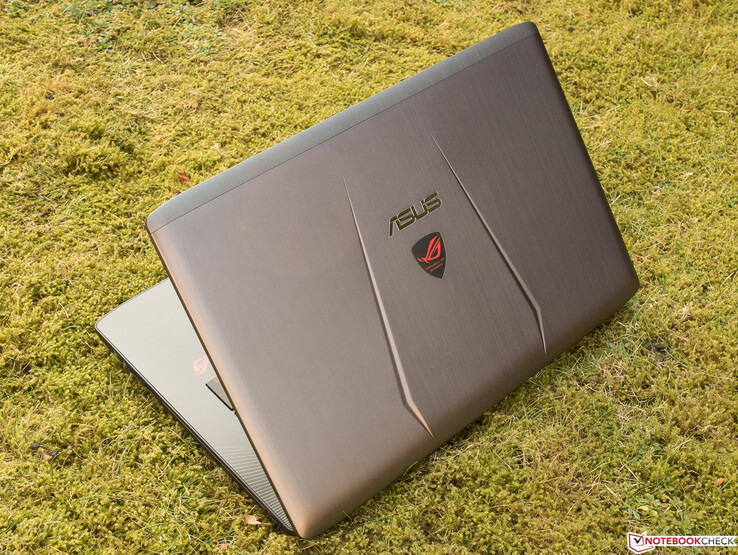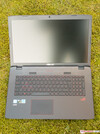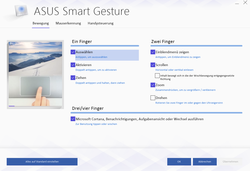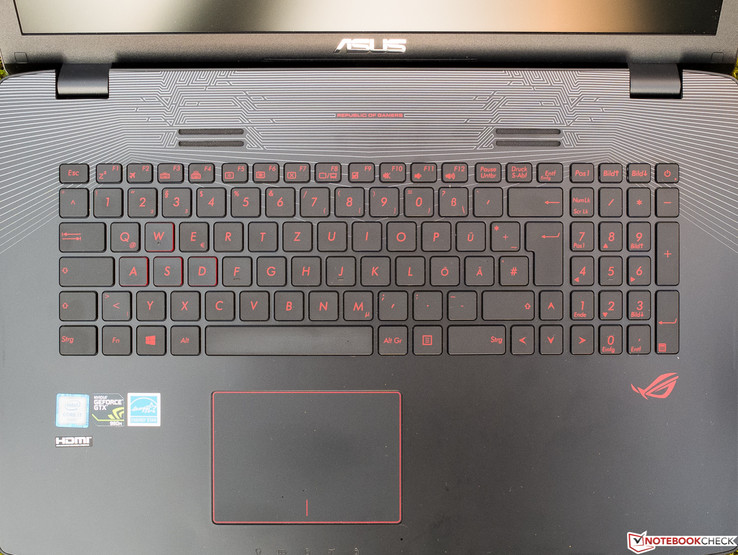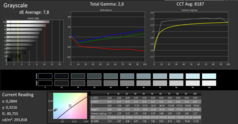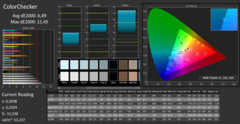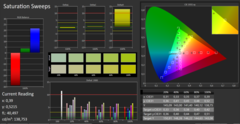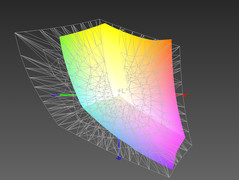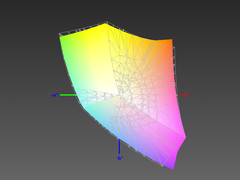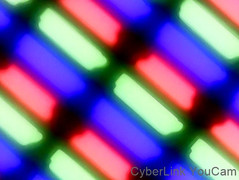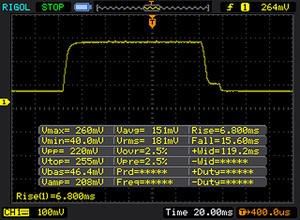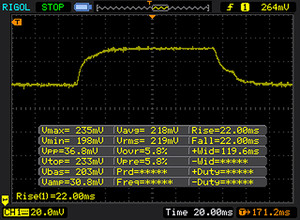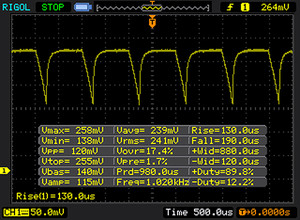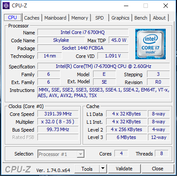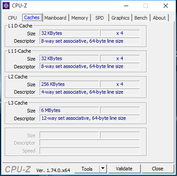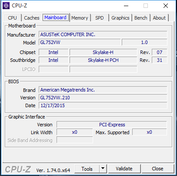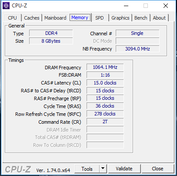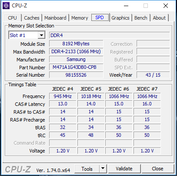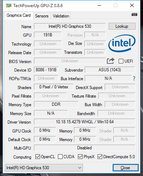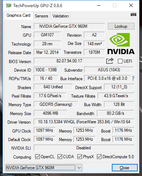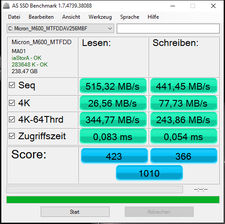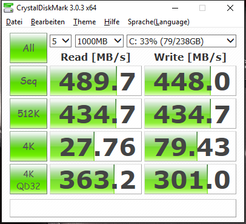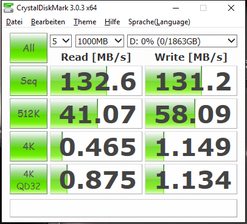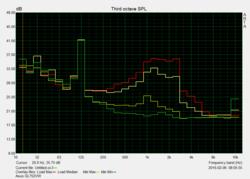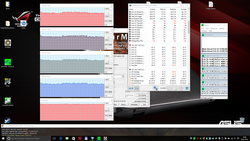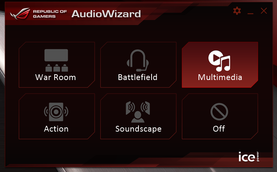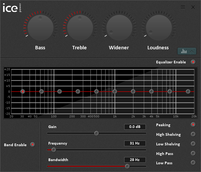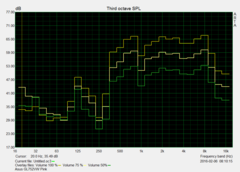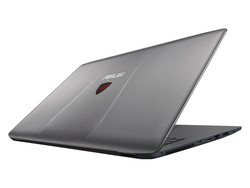Asus GL752VW Notebook Review

For the original German review, see here.
Asus’ new GL752VW is based on the gaming-focused ROG-series, but we consider it to be a multimedia notebook because of the Nvidia GeForce GTX 960M. With a 17.3-inch display and a weight of around 3 kg (~6.6 lb) for our review configuration T4168T, it is predestined for stationary operation. Thanks to a fast quad-core and 8 GB RAM, the test device provides sufficient performance even for demanding software as well as excessive multitasking. The 256 GB SSD promises smooth handling and plenty of storage for media files, for example, is provided by the conventional 2 TB hard drive. Games are generally GPU-bound and are less reliant on the CPU. Gamers will be happy about the Full HD resolution, but not so much about the fact that the panel is exclusively based on the TN technology.
Some information about the versions of the GL752VW: According to the Asus website, the device is also available with a slightly slower Intel Core i5-6300HQ instead of the i7-6700HQ (4 x 2.6 – 3.5 GHz, Hyperthreading, TDP 45 W) from our T4168T. The i5 has the same TDP, but lower clocks and does not support Hyperthreading, even though this should not be a crucial point for games. There are numerous options in terms of memory, storage and optical drive. All models are equipped with the GTX 960M GPU, but some models only have 2 GB DDR5-VRAM according to Asus. Some versions are shipped without OS, or you get a preloaded version of Windows 10 Home. A big price comparison website listed 13 versions at the time of this writing with prices between 940 up to 1550 Euros (~$1054 to $1738).
We selected some 17-inch comparison devices with similar price and performance figures for this review. An important competitor is the highly rated Acer Aspire V Nitro Black Edition VN7-792G-74Q4 for around 1200 Euros (~$1346). Other rivals are the HP Envy 17-n107ng for 1500 Euros (~$1684), the MSI PE70-2QEi581, which retailed for 1300 Euros (~$1458) last July, as well as the Lenovo IdeaPad Y700 17ISK for $1150 we reviewed this January.
Case
If you look at the opened Asus GL752VW, it is identical to the smaller 15-inch Asus GL552JX we reviewed back in August 2015. We do not want to repeat ourselves, so we will only cover the changes and build quality. While the lid of the GL552JX was primarily covered by a dark-gray and textured plastic surface, our review model uses a light-gray brushed metal finish with a hardly describable color cast, which is also used for the central inlay of the older Asus notebook and seems to be made of aluminum. The visually separated top edge of the lid on the other hand is colored in a neutral gray. At the bottom is a modified maintenance hatch, and the battery is, contrary to the older 17-inch device, not accessible from the outside.
We did not notice any irregularities in respect of the build quality this time. All edges of the base, except for the carefully integrated DVD tray, are flush and the gaps are even. You can slightly twist the base unit with some force, but it leaves a solid impression in general and there is no creaking. It is no problem to open the lid with one hand. It only bounces a bit, but the display will open further up to the maximum opening angle when you use the notebook on your lap and wiggle around a bit.
Connectivity
Besides the essentials including Gigabit-Ethernet, the GL752VW also provides a Mini-DisplayPort as well as one USB 3.1 Type-C port, but no VGA output in return. However, two of the three available conventional USB ports only support the standard 2.0. Audio input and output are separated, so you can use common headsets. Similar to the GL552JX, Asus unfortunately located all ports very far at the front, which does not improve the handling. We were able to copy large files from an external USB 3.0 drive of the author with the expected 100 MB/s to the internal SSD.
We use our reference SD-card, the Toshiba Exceria Pro SDXC 64 GB UHS-II, to evaluate the performance of the card reader. The maximum transfer rate is 86 MB/s for large files, while usual JPG pictures with around 5 MB each are copied at around 65 MB/s. Those are good results.
Communication
Asus uses a modern Intel module with the designation Dual-Band Wireless-AC 8260 for Wi-Fi connections. Besides the still very popular standards IEEE 802.11 g and n, it also supports the ac standard in the less crowded 5 GHz band. More information about the module, which also supports Bluetooth 4.1, is available directly from Intel. The signal quality was unremarkable in our individual test environment.
Accessories
Besides the usual quick-start guide and warranty information as well as the power adapter, the box includes the usual ROG accessories: a microfiber cloth and zip ties. Other accessories with an ROG-related design are available here.
Maintenance
You can access the HDD, RAM slots and M.2-SSD via a maintenance hatch at the bottom, which is only secured by two screws. All other components like the fan require further disassembly.
Warranty
Asus grants a 24-month warranty.
Input Devices
Touchpad
The handling of the completely smooth and conveniently sized ClickPad surface, which does not have dedicated buttons, also works very well with slightly moist fingers. Similar to many other touchpads, this model does not accept inputs at the edges. Response and precision do not cause any criticism; Drag’n’Drop with a double tap always worked reliably. Thanks to a firm, but well-adjusted resistance, firm pressure point and clearly audible feedback, the ClickPad "buttons" leave a good impression as well. Asus Smart Gesture (see pictures) allows easy configuration of gestures with up to three fingers.
Keyboard
It seems Asus uses the same Chiclet keyboard we already know from the GL552JX, at least we cannot find any visual or tactile differences. Unfortunately, this also means we get the smaller and not ergonomically ideal numpad, despite the sufficient space. The power button with a status LED was also included as the top right button. Otherwise, the layout pretty much meets the expectations.
All in all, the keyboard leaves a solid and sophisticated impression, which also includes the evenly distributed red illumination. It can be dimmed in three steps and obviously be completely deactivated. You can only slightly dent it when you apply unrealistically high amounts of pressure. All keys have an anti-slip surface. The regular keys seem to have a slight conical curvature, while the keys from the numpad are flat. The dark red lettering is usually easy to read, but the contrast compared to the black keys is not sufficient when the illumination is active. Thanks to transparent edges, you can easily identify the WASD keys. Key travel cannot be compared with normal desktop inputs, but is sufficient in our opinion. Similar to the GL552JX, we would have preferred a firmer stroke, but this is a matter of taste. There were no problems with the well-defined pressure point and the restrained noise development.
Display
Full HD is still the preferred resolution from a gamer’s perspective. Less pixels look worse, and higher resolutions are usually too demanding for mobile GPUs. The pixel density of 157 PPI in combination with the 17.3-inch screen is sufficient but not very generous. Users with good eyesight might see some individual pixels at a small distance. Despite the high price, Asus decided to use a TN panel, which is at least matte. The determined brightness of 289 cd/m² (center) is average in this class, but not outstanding.
A brightness distribution of 82% does not win any awards, and we could subjectively see the backlight illumination at the sides with a dark picture. However, it was even and we would not call it screen bleeding. This can be annoying when you watch videos with dark passages, for example. The display brightness does not differ dramatically within the comparison. Except for the MSI, all the devices are about 20% brighter, but who uses a display at 350 cd/m² indoors? You would almost need sunglasses in this case. The advantage might pay off when you plan to use the notebook outdoors though.
| |||||||||||||||||||||||||
Brightness Distribution: 82 %
Center on Battery: 289 cd/m²
Contrast: 1156:1 (Black: 0.25 cd/m²)
ΔE ColorChecker Calman: 6.49 | ∀{0.5-29.43 Ø4.78}
ΔE Greyscale Calman: 7.8 | ∀{0.09-98 Ø5}
95% sRGB (Argyll 1.6.3 3D)
60% AdobeRGB 1998 (Argyll 1.6.3 3D)
65.7% AdobeRGB 1998 (Argyll 3D)
95.3% sRGB (Argyll 3D)
64.9% Display P3 (Argyll 3D)
Gamma: 2.6
CCT: 8187 K
The combination of low black levels and high maximum brightness has resulted in an excellent contrast of 1156:1. Only the Acer and Lenovo can keep up; they also produce rich blacks and are even brighter than our model. The MSI and HP in particular suffer from high black values, and we can only measure a very weak contrast of 305:1 for the latter.
Color deviations with DeltaE values of 12 and more are not uncommon for TN panels. With this in mind, the measured results of 6 and 8 (grayscale) are certainly not good, but still reasonable for a TN panel. We can see a slight cyan cast, which can probably be removed with the attached (see box) color profile. All the rivals manage much more accurate colors ex-works and are not that far away from the ideal values (less than 3). The gamma value is too high at 2.6 (ideal: 2.2 for Windows). The results of the rivals already show that the excellent color space coverage of our TN panel is on par with modern IPS screens. After successful calibration, the performance is actually sufficient for semi-professional picture editing with 95% sRGB.
| Asus GL752VW-T4168T | Acer Aspire V Nitro Black Edition VN7-792G-74Q4 | HP Envy 17-n107ng | MSI PE70-2QEi581 | Lenovo Ideapad Y700 17ISK 80Q0 | |
|---|---|---|---|---|---|
| Display | 0% | 2% | -5% | -4% | |
| Display P3 Coverage (%) | 64.9 | 67 3% | 65.7 1% | 66.6 3% | 67.4 4% |
| sRGB Coverage (%) | 95.3 | 91.3 -4% | 97.2 2% | 84.6 -11% | 84.8 -11% |
| AdobeRGB 1998 Coverage (%) | 65.7 | 66.7 2% | 67.6 3% | 61.9 -6% | 62 -6% |
| Response Times | -30% | -28% | -37% | ||
| Response Time Grey 50% / Grey 80% * (ms) | 44 ? | 58 ? -32% | 49 ? -11% | 51.6 ? -17% | |
| Response Time Black / White * (ms) | 22 ? | 28 ? -27% | 32 ? -45% | 34.4 ? -56% | |
| PWM Frequency (Hz) | 1020 ? | 198 ? | |||
| Screen | 15% | -32% | -9% | 13% | |
| Brightness middle (cd/m²) | 289 | 346 20% | 341 18% | 305 6% | 349.7 21% |
| Brightness (cd/m²) | 268 | 326 22% | 325 21% | 265 -1% | 332 24% |
| Brightness Distribution (%) | 82 | 88 7% | 91 11% | 79 -4% | 90 10% |
| Black Level * (cd/m²) | 0.25 | 0.32 -28% | 1.05 -320% | 0.5 -100% | 0.304 -22% |
| Contrast (:1) | 1156 | 1081 -6% | 325 -72% | 610 -47% | 1150 -1% |
| Colorchecker dE 2000 * | 6.49 | 4.01 38% | 4.6 29% | 4.83 26% | 3.99 39% |
| Colorchecker dE 2000 max. * | 11.45 | 8.74 24% | |||
| Greyscale dE 2000 * | 7.8 | 3.58 54% | 6.08 22% | 3.29 58% | 3.34 57% |
| Gamma | 2.6 85% | 2.23 99% | 2.43 91% | 2.39 92% | 2.23 99% |
| CCT | 8187 79% | 6426 101% | 7627 85% | 7080 92% | 6111 106% |
| Color Space (Percent of AdobeRGB 1998) (%) | 60 | 62 3% | 56 -7% | 55.8 -7% | |
| Color Space (Percent of sRGB) (%) | 95 | 97 2% | 84 -12% | 84.8 -11% | |
| Total Average (Program / Settings) | -5% /
4% | -19% /
-24% | -7% /
-8% | -9% /
3% |
* ... smaller is better
The left picture shows the visibility under direct sunlight – basically nothing, despite the matte surface and decent brightness. As long as we stay in the shade (right picture), the maximum luminance will be sufficient for comfortable working. But who uses a 3 kg (~6.6 lb) 17-inch device on your lap in the sunny park?
Display Response Times
| ↔ Response Time Black to White | ||
|---|---|---|
| 22 ms ... rise ↗ and fall ↘ combined | ↗ 7 ms rise | |
| ↘ 15 ms fall | ||
| The screen shows good response rates in our tests, but may be too slow for competitive gamers. In comparison, all tested devices range from 0.1 (minimum) to 240 (maximum) ms. » 47 % of all devices are better. This means that the measured response time is similar to the average of all tested devices (20.2 ms). | ||
| ↔ Response Time 50% Grey to 80% Grey | ||
| 44 ms ... rise ↗ and fall ↘ combined | ↗ 22 ms rise | |
| ↘ 22 ms fall | ||
| The screen shows slow response rates in our tests and will be unsatisfactory for gamers. In comparison, all tested devices range from 0.165 (minimum) to 636 (maximum) ms. » 72 % of all devices are better. This means that the measured response time is worse than the average of all tested devices (31.6 ms). | ||
Screen Flickering / PWM (Pulse-Width Modulation)
| Screen flickering / PWM detected | 1020 Hz | ≤ 90 % brightness setting | |
The display backlight flickers at 1020 Hz (worst case, e.g., utilizing PWM) Flickering detected at a brightness setting of 90 % and below. There should be no flickering or PWM above this brightness setting. The frequency of 1020 Hz is quite high, so most users sensitive to PWM should not notice any flickering. In comparison: 53 % of all tested devices do not use PWM to dim the display. If PWM was detected, an average of 8111 (minimum: 5 - maximum: 343500) Hz was measured. | |||
The viewing angle stability of the Chi-Mei display is good for TN standards, but it can still not compete with IPS panels. You will see annoying brightness and contrast limitations when you shift your horizontal viewing position by more than 45 degrees. Much smaller is the tolerance with vertical shifts. Here we can quickly see the milky picture impression, which is typical for TN-panels. Low-end TN screens often show inverted colors even with small shifts, but this is not the case for our review unit. Overall, the Asus GL752VW provides acceptable viewing angles.
Performance
Processor
Announced back in September last year, the quad-core CPU Intel Core i7-6700HQ (4x 2.6 – 3.5 GHz, Hyperthreading) is a good choice if you need a powerful mobile processor and the chassis can handle the heat of the 45-watt TDP, which is the case for our 17-inch device. Smaller notebooks (< 15 inches) can usually only handle the chip when the TDP is reduced to 35 watts. Similar to the previous generations, the performance of the new Skylake CPUs was just slightly improved, but there were more significant efficiency improvements, which is very important in the mobile range.
The nominal clock is 2.6 GHz, but the cores can reach up to 3.5 GHz via Turbo Boost. The limit is 3.1 GHz when you stress all four cores and 3.3 GHz for two active cores. The performance is on par with the older and slightly higher clocked i7-4810MQ (4x 2.6 – 3.6 GHz, Hyperthreading, TDP 47 watts) and the Cinebench results are also on par with similarly equipped notebooks. The CPU was able to maintain 3.1 GHz in a CB Multi loop, so the Turbo utilization of the Asus GL752VW-T4168T is perfect in these conditions. The clock will frequently drop to just 800 MHz on battery.
System Performance
The system performance of the Asus GL752VW is, as expected, very good. It is one of the fastest multimedia notebooks we reviewed over the last 8 months according to the PCMark 7 score. The fastest device (+ 16%) is the MSI GP62-2QEi781FD (i7-5700HQ, GTX 950M). Within the comparison, both the HP Envy as well as the Lenovo IdeaPad, which are also equipped with an i7-6700HQ and a GTX 960M, are slightly faster than the Asus, but 6 and 7%, respectively, are negligible in practice. That the other two notebooks fall behind is a result of their conventional hard drives. The storage results are more important in PCMark 7 than 8, where the comparison devices are closer to each other and roughly on par.
Subjectively, working with the GL752VW was a very enjoyable experience. Annoying delays, like when you launch an application (for the first time) are usually no problem, and even 15 tabs in Chrome at the same time did not affect the smooth handling. The notebook also launched very quickly.
| PCMark 7 Score | 5544 points | |
| PCMark 8 Home Score Accelerated v2 | 3434 points | |
| PCMark 8 Creative Score Accelerated v2 | 4349 points | |
| PCMark 8 Work Score Accelerated v2 | 4648 points | |
Help | ||
Storage Devices
The 256 GB Micron M.2-SSD is attached via a SATA-3 interface, so there are limitations at around 500 MB/s for sequential operations. However, this should be noticeable only with large games, if at all. Much more important in practice is the read performance of small files (4K Read), where some modern SSDs manage up to 40 MB/s. A good result would be around 30 MB/s, which is just missed by our Asus. The Micron SSD is average when you read small files with multiple threads simultaneously (4K-64 read). The additional 2 TB hard drive performs very well.
GPU Performance
We have already tested the popular performance graphics card Nvidia GeForce GTX 960M several times and it is used in dozens of notebooks, just like the technically similar predecessor, the GTX 860M. Our Asus is equipped with the biggest version of the Maxwell graphics card with 4 GB GDDR5-VRAM (128-bit interface), which runs effectively at 5,000 MHz. Despite the high performance, it is still significantly slower than the current mobile high-end chips GTX 970M and GTX 980M, but they also require a more complex and potentially louder cooling solution; they obviously consume more power as well.
The chip does support DirectX 12 in combination with Windows 10, but only feature level 11_0. Besides improved efficiency, the GPU also scores with the capability to decode 4K videos. Thanks to the DisplayPort, those videos can also be transferred to suitable monitors at 60 Hz. The HDMI port, on the other hand, can only drive a 4K panel at 30 Hz, because it lacks the 2.0 standard. Gamers will usually stay at Full HD, and the GTX 960M cannot handle more, at least with modern and GPU demanding titles and high details.
The 3DMark 11 scores are pretty sobering compared to other notebooks with the same GPU, even though they sometimes only have 2 GB VRAM. The GPU in our review unit is actually one of the slowest within the comparison. The similarly equipped Acer Aspire VN7-591G-727P managed a 15% higher score, for example, but the difference compared to other 960 chips is usually up to 6%. The results in the Fire Strike test of the current 3DMark (2013) are very similar, and the rivals with a GTX 960M were once again between 2-6% faster. The performance will be reduced by around 55% (2276 points) on battery power. The run on battery power actually produced serious picture interferences, which was reproducible. Only a restart helped, so what is going on?
| 3DMark 11 - 1280x720 Performance GPU (sort by value) | |
| Asus GL752VW-T4168T | |
| Acer Aspire V Nitro Black Edition VN7-792G-74Q4 | |
| HP Envy 17-n107ng | |
| MSI PE70-2QEi581 | |
| Lenovo Ideapad Y700 17ISK 80Q0 | |
| 3DMark | |
| 1920x1080 Fire Strike Graphics (sort by value) | |
| Asus GL752VW-T4168T | |
| Acer Aspire V Nitro Black Edition VN7-792G-74Q4 | |
| HP Envy 17-n107ng | |
| Lenovo Ideapad Y700 17ISK 80Q0 | |
| 1280x720 Cloud Gate Standard Graphics (sort by value) | |
| Asus GL752VW-T4168T | |
| Acer Aspire V Nitro Black Edition VN7-792G-74Q4 | |
| HP Envy 17-n107ng | |
| Lenovo Ideapad Y700 17ISK 80Q0 | |
| 3DMark 11 Performance | 5327 points | |
| 3DMark Cloud Gate Standard Score | 16847 points | |
| 3DMark Fire Strike Score | 3913 points | |
Help | ||
Gaming Performance
Our small benchmark table contains the important aspects: Many modern games can at least be played smoothly with high settings and in Full HD, while very complex titles like the brand-new XCOM 2 require medium settings. Older, but visually still appealing games like Bioshock Infinite from 2013 can sometimes be played with the highest settings. More games that are running on the GTX 960M are listed in our dedicated article for the GPU.
| low | med. | high | ultra | |
|---|---|---|---|---|
| Rainbow Six Siege (2015) | 105 | 55.5 | 45.6 | |
| Just Cause 3 (2015) | 63.5 | 33.8 | 28.9 |
Emissions
System Noise
The fans are deactivated while idling, and you can only hear the murmur of the hard drive when you are very close to the device. It took around 15 seconds after we launched Prime95 before we noticed a gentle murmur from a distance of around half a meter (~1.6 feet). Such a behavior usually indicates effective passive cooling capabilities. It did not get louder until we activated the GPU stress test FurMark. It was still an insignificant murmur, but it got louder. The maximum fan noise was also audible from a couple of meters (~6.6 feet), but there were no annoying noises like a whistling sound. This kind of sustained maximum load is not even caused by demanding games. None of the rivals is quieter in all scenarios
Noise level
| Idle |
| 32 / 32 / 32 dB(A) |
| HDD |
| 32.9 dB(A) |
| DVD |
| 36.2 / dB(A) |
| Load |
| 43.8 / 44 dB(A) |
 | ||
30 dB silent 40 dB(A) audible 50 dB(A) loud |
||
min: | ||
Temperature
The surface temperatures reached up to 44 °C (111.2 °F) under sustained maximum load in the area of the touchpad, but the hand is further at the left side during gaming, where we can only measure a comfortable 31 °C (87.8 °F). The highest temperature at the bottom is 45 °C (113 °F). Most users that actually use the notebook on the lap to play games should not have a problem with this temperature. The HP Envy 17 can score with unusually low 25-26 °C (77-78.8 °F) while idling, but gets extremely hot with up to 82 °C (179.6 °F) under load. In contrast, the MSI PE70 gets rather warm while idling, but has no problems under load. Our test device manages a very good 91% in the temperature sub-rating.
CPU temperatures of up to 92 °C (197.6 °F) are a bigger problem, which are the result of our stress test with Prime95 and FurMark running simultaneously. HWiNFO64 (picture) indicates thermal throttling for some cores. The cores were able to maintain the specified 3.1 GHz at first, but then fluctuated between 2.5 and 2.9 GHz. The nominal clock of 2.6 GHz cannot be maintained all the time. Not even games will result in such a high and sustained load, so you can expect a good Turbo utilization in practice according to the Cinebench results.
(±) The maximum temperature on the upper side is 44.1 °C / 111 F, compared to the average of 36.9 °C / 98 F, ranging from 21.1 to 71 °C for the class Multimedia.
(±) The bottom heats up to a maximum of 44.8 °C / 113 F, compared to the average of 39.2 °C / 103 F
(+) In idle usage, the average temperature for the upper side is 26.8 °C / 80 F, compared to the device average of 31.3 °C / 88 F.
(-) The palmrests and touchpad can get very hot to the touch with a maximum of 44.1 °C / 111.4 F.
(-) The average temperature of the palmrest area of similar devices was 28.7 °C / 83.7 F (-15.4 °C / -27.7 F).
Speakers
Our GL752VW is still equipped with two speakers above the keyboard as well as a "subwoofer" at the bottom, which obviously cannot produce real bass. Music is very focused on high tones with the default multimedia preset, which should be a result of the necessary compression. The sound, which is often unnatural and shrill, does at least provide some kind of dynamics, but there is hardly any spatial effect even with titles like "May It Be" from Enya. The weak sound system does not have such a big effect on movies and games, but we cannot call it an enjoyable experience.
Despite the sufficiently rich sound, the maximum volume is actually not very high and is only enough for medium-sized rooms. There were no significant distortions or volume fluctuations. You can get a completely different sound in combination with good headphones, which should also satisfy demanding users.
Energy Management
Power Consumption
Very good: Compared to the majority of notebooks, our review unit does not pull any power from the socket when it is turned off, and only 0.5 watts in standby. If you compare the consumption with similarly equipped GTX 960M multimedia notebooks, our model is average under load, but usually consumes more power while idling. The 120-watt power adapter can handle the maximum consumption of 114 watts.
| Asus GL752VW-T4168T GeForce GTX 960M, 6700HQ, Micron M600 MTFDDAV256MBF mSATA | Acer Aspire V Nitro Black Edition VN7-792G-74Q4 GeForce GTX 960M, 6700HQ, Toshiba MQ02ABD100H | HP Envy 17-n107ng GeForce GTX 950M, 6700HQ, Samsung SSD PM851 MZNTE512HMJH | MSI PE70-2QEi581 GeForce GTX 960M, 4210H, Toshiba HG5d THNSNH256GMCT | |
|---|---|---|---|---|
| Power Consumption | 21% | 35% | -29% | |
| Idle Minimum * (Watt) | 14.5 | 5.8 60% | 5.5 62% | 19.1 -32% |
| Idle Average * (Watt) | 19.3 | 9 53% | 10.8 44% | 24.3 -26% |
| Idle Maximum * (Watt) | 19.5 | 14.7 25% | 11 44% | 29.2 -50% |
| Load Average * (Watt) | 78 | 85 -9% | 72 8% | 88.6 -14% |
| Load Maximum * (Watt) | 100 | 121.5 -22% | 85 15% | 122 -22% |
* ... smaller is better
| Off / Standby | |
| Idle | |
| Load |
|
Key:
min: | |
Battery Runtime
Within the comparison, both the Acer Aspire Nitro (53 Wh) as well as the MSI PE70 (41 Wh) are good for a direct comparison with our Asus GL752VW (48 Wh) due to somewhat similar battery capacities. The additional consumption is at least noticeable compared to the Acer, because the stamina while idling is not competitive. The consumption and the runtimes of the MSI are much closer to our review unit. Only two and a half hours in our realistic Wi-Fi surfing test are not good in general, but should not be that important for many users who primarily want to use it as a stationary device.
Pros
Cons
Verdict
The new GL752VW from Asus is a success in general. We would have liked to see an IPS display, at least as an optional extra, but the TN panel is at least one of the better models. This is evident when you consider the reasonable viewing angle stability and the great color space coverage. It is also rather unfortunate that the sound system of the multimedia notebook is disappointing. We can see good, but inconsistent approaches in terms of maintenance. There is still the question about the reproducible crashes on battery power, which could also be an issue when you play games or run other GPU demanding applications.
The reasonably priced Asus GL752VW does not reveal any serious issues that would prevent us from a purchase. Case, input devices and almost all technical aspects are convincing.
The manufacturer deserves a special praise for the almost ideal storage configuration consisting of a fast 256 GB SSD and a huge 2 TB HDD. This is also the biggest issue of the slightly higher rated Acer Aspire Nitro, where you have to live with a 1 TB hybrid hard drive, so the handling is not quite as responsive.
Asus GL752VW-T4168T
- 12/09/2016 v6 (old)
Sven Kloevekorn




